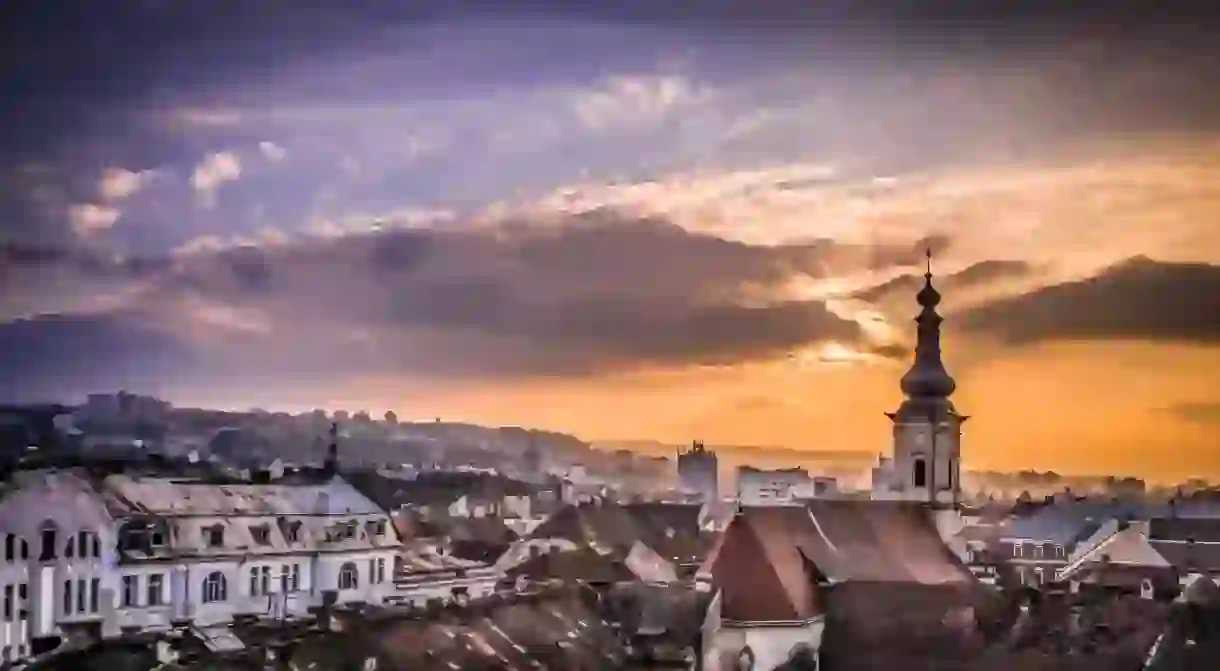An Architectural Tour of Cluj Napoca's Most Beautiful Landmarks

Over the centuries, several populations and various artistic movements shaped Cluj Napoca‘s extension and evolution. The city as we see it today is a smorgasbord of architectural styles, creating a picturesque scenery. From Gothic to Renaissance to Eclectic, from majestic churches to centuries-old buildings, the city’s facades are marvellous artistic creations that adorn Cluj’s squares and streets. The best way to discover its most beautiful monuments is by looking up, allowing yourself to observe and admire.
Begin your tour in the charming Museum square where narrow, hidden streets invite you to discover. Here, the history of the city started to be written centuries ago when the first fortified citadel of Cluj was built. Nowadays, the Franciscan Monastery stands as a witness of the years that have passed, transformed by the city’s development. Located on the ruins of a former Romanesque church, its shape has changed from Romanesque to Gothic to Baroque. Today, only the old monastery kept its gothic style while within the church intricate Baroque decorations strike you from the moment you step inside. After a moment of silent wonderment, take the square’s cobbled streets towards Matthias Corvin’s house.
The white, secular building where the Hungarian king Matthias Corvin was born in the 15th-century is today housing the Art and Design University. Nevertheless, the monument’s architecture was preserved: a gothic irregular structure with Renaissance windows. You can visit the ground floor’s hallway, but for the rooms, you have to ask the guardian’s permission as it is a public institution. Once you are again outside, follow the street that goes towards the Union Square. On the little street, there is a traditional restaurant, Matei Corvin, where you can come later for your meal.

In the Union Square, the Gothic Church ‘Saint Michael‘ is remarkable. The second biggest gothic church between Istanbul and Wien, the monument dominates the square. Built in the 14th-15th centuries in a Transylvanian gothic style, the church bears the marks of the different religious movements that changed the local’s beliefs: beautifully decorated with frescoes till the 16th-century, the church’s walls were left blank after the religious reform when the Catholic priests were chased away from the citadel and the Unitarians got installed. Later, during the Catholic reinstatement, the church was enriched with a neo-gothic altar and a baroque pulpit. But one of its most valuable pieces remains the stunning organ. Today, organ concerts are held every Saturday inside.

Centuries-old houses displaying an array of architectural styles surround the church. Stop in front of the Banffy Palace, a 18th-century edifice considered the most beautiful baroque palace in Transylvania. On top of the construction, the Banffy’s family coat of arms is standing proudly, a gryphon, half lion half eagle, ruler of both the ground and the sky. Today, you can visit the National Art Museum inside. Next to it, two buildings mirror one another. Marvels of the eclectic style, the ‘Twin Buildings’ used to be the equivalent of ‘Galleries Lafayette’ in the 20th-century, with deluxe shops and apartments.
Right in the centre of the square, Matthias Corvin’s statue astonishes the visitors. With a project that won the ‘Grand Prix’ at the Universal Exhibition of Paris in 1900, the architects Fadrusz Janos and Pakey Lajos gave the city a monument that became one of its most startling landmarks. Facing the statue is the biggest palace in Cluj, erected by David Sebestyen, a visionary architect of the 20th-century. Opposite, a pearl of the eclectic architecture, the Continental Hotel, possessing an ethereal beauty. The building used to be one of the most luxurious hotels in the city a century ago.
Take the street in between and soon you will be in front of the first Catholic church in Transylvania built after the religious reform: the Piarist Church. Maybe you didn’t notice it before or you didn’t even know it’s a church, but once you get inside you will be mesmerized. With a tall nave, small lateral chapels and an altar that leaves you in awe, the church is a baroque treasure. Made to impress but also as a place of gratitude, each chapel is dedicated to a saint and garnished with gratitude plaques left by the locals.

You might not want to leave this place soon, but when you do, take the Kogalniceanu street and don’t stop until you see Saint George killing the dragon. The 14th-century statue is a copy of the original kept in Prague. The statue was carved by the local masters Martin and Gheorghe at the request of the bohemian king Carol IV, and for its time it was an absolute masterpiece. In Cluj, you have its facsimile. Behind the statue, the Reformed Church rises. Built in a Gothic style in the 15th-century, the monument was recently restored and today exhibits the biggest collection of Transylvanian coat of arms.
Close to the church, in the Avram Iancu square, two monumental landmarks are facing each other: the Art Nouveau building of the National Theatre and Opera of Cluj, built at the beginning of the 20th-century by the Austrian company Helmer and Fellner and the 21st century Orthodox Cathedral, a symbol of the Romanian’s spirituality. While for a visit of the theatre and opera building you’ll have to book a ticket for a play, you can visit the Orthodox Cathedral as long as you are properly dressed. Decorated with frescoes, mosaic and an impressive chandelier, gifted from King Carol II of Romania, the cathedral’s interior is outstanding.

If you still haven’t got your ‘architecture dose’, go back to the main square following the Heroes Boulevard, a street garnished with architectural wonders waiting to be discovered.
Remember, look up to discover Cluj’s architectural marvels.













